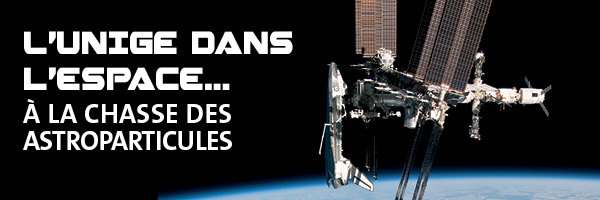
Switzerland has a long history of involvement in cosmic-ray physics and space research projects: some of the most notable examples are its pioneering research since the beginning of the 20th century; its co-founding of major European space organisations, its provision of state-of-the-art scientific equipment to major international space agencies and the missions of a Swiss astronaut in the 1990s.
The Alpha Magnetic Spectrometer (AMS) project, whose control centre is at CERN, has benefitted from the cutting-edge knowhow of the Nuclear and Corpuscular Physics Department (DNPC) of the University of Geneva (UNIGE). An extremely sensitive, high-resolution spectrometer was built for the project and was installed on the International Space Station (ISS) in 2011. The DNPC was responsible for designing the particle tracker – the device at the heart of both the AMS 01 prototype and the final model sent into space, AMS 02. The aim of this research project is to advance humankind’s knowledge of the particles observed directly in space. UNIGE physicists are following its progress closely by participating in the scientific analysis of the data collected.
Physicists around the world are still curious to know where all the antimatter has gone. The Big Bang theory predicts that matter and antimatter existed in equal quantities in the very early universe. So far, we have been able to exclude the presence of large quantities of antimatter around our galaxy cluster, but what about the rest of the universe? By hunting astroparticles, physicists hope to find some small trace of primordial antimatter – if it still exists and if we can build detectors and send them off to find it in the middle of the universe!
Find out all about this exciting cutting-edge research, in which UNIGE plays a leading role.
- "L’UNIGE dans l’espace… à la chasse des astroparticules"
An exhibition on cosmic rays hosted by the Nuclear and Corpuscular Physics Department.
UNIGE exhibition hall (SEU) - Uni Carl Vogt - 66 Boulevard Carl-Vogt.
From 18 August to 30 September, Monday to Friday from 8 a.m. to 7 p.m. Free entry.
Guided tours of the exhibition will be available from 12.30 to 1.30 p.m. on Thursday, 25 August and Tuesday, 27 September. Register here.
- Tour of the AMS Control Centre at CERN – the only control centre linked to the International Space Station (ISS) based outside NASA.
Thursday, 15 September at lunchtime (exact time to be confirmed). Register here.
- Broadcast of the launch of the astroparticle detector POLAR.
Sunday, 18 September in the UNIGE exhibition hall (SEU) - Uni Carl Vogt - 66 Boulevard Carl-Vogt.
The exact time will be confirmed a few days before the event and may be changed at short notice.
- “The Cosmos is the Ultimate Laboratory”, a lecture by Samuel Ting, Nobel laureate in physics and head of the AMS experiment.
Tuesday, 27 September at 6.30 p.m. in the auditorium of the Musée d’Ethnographie de Genève (MEG). Register here.
Webiste of the event: http://www.unige.ch/-/astroparticules/